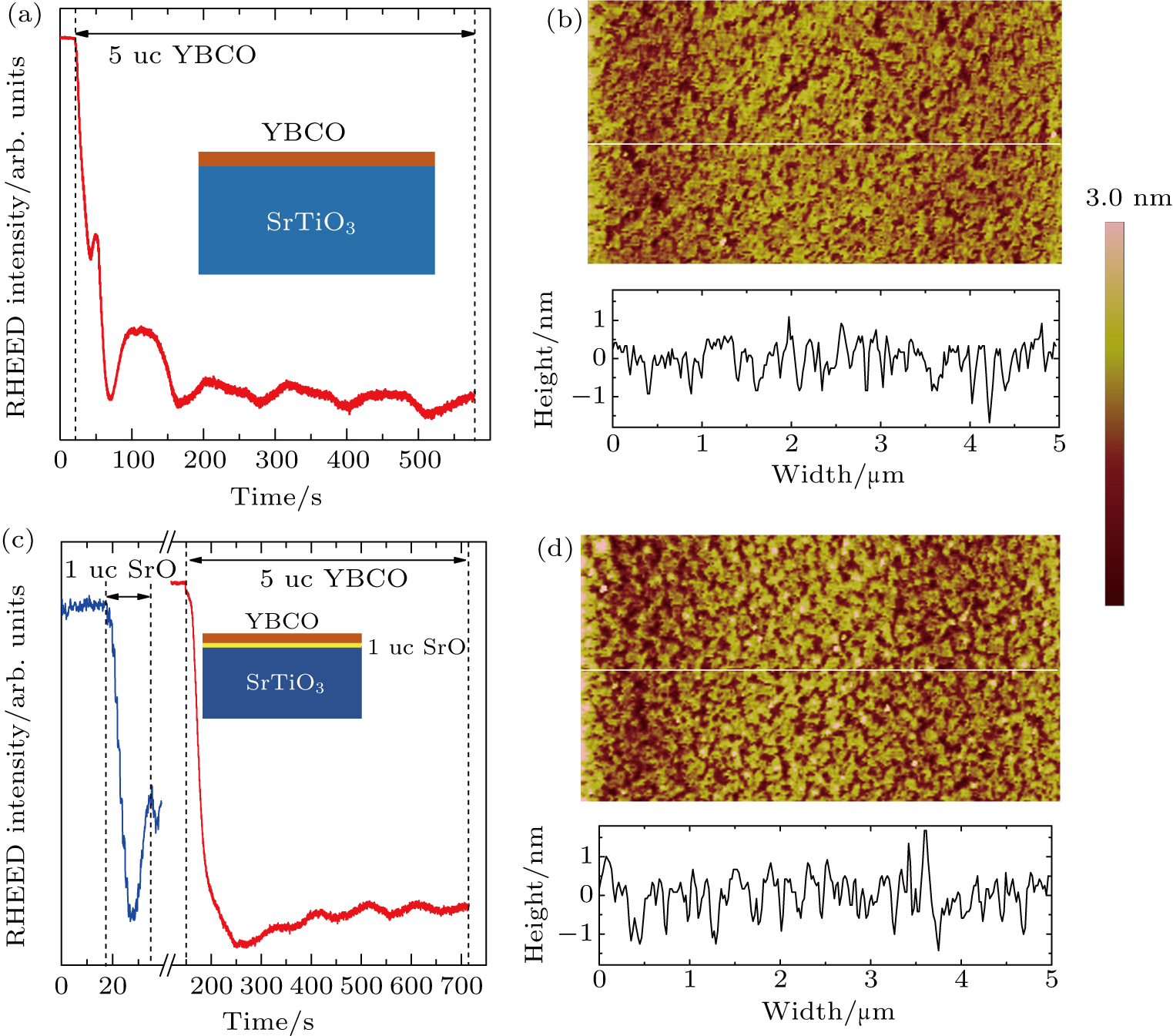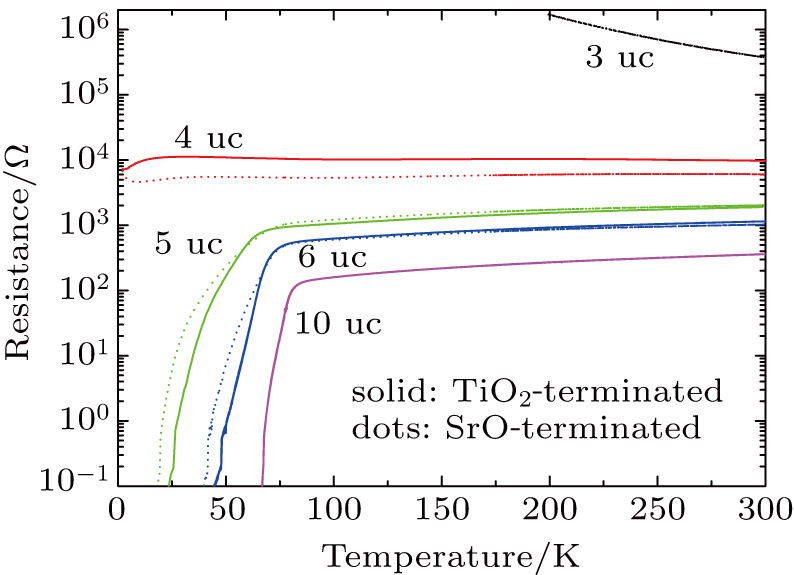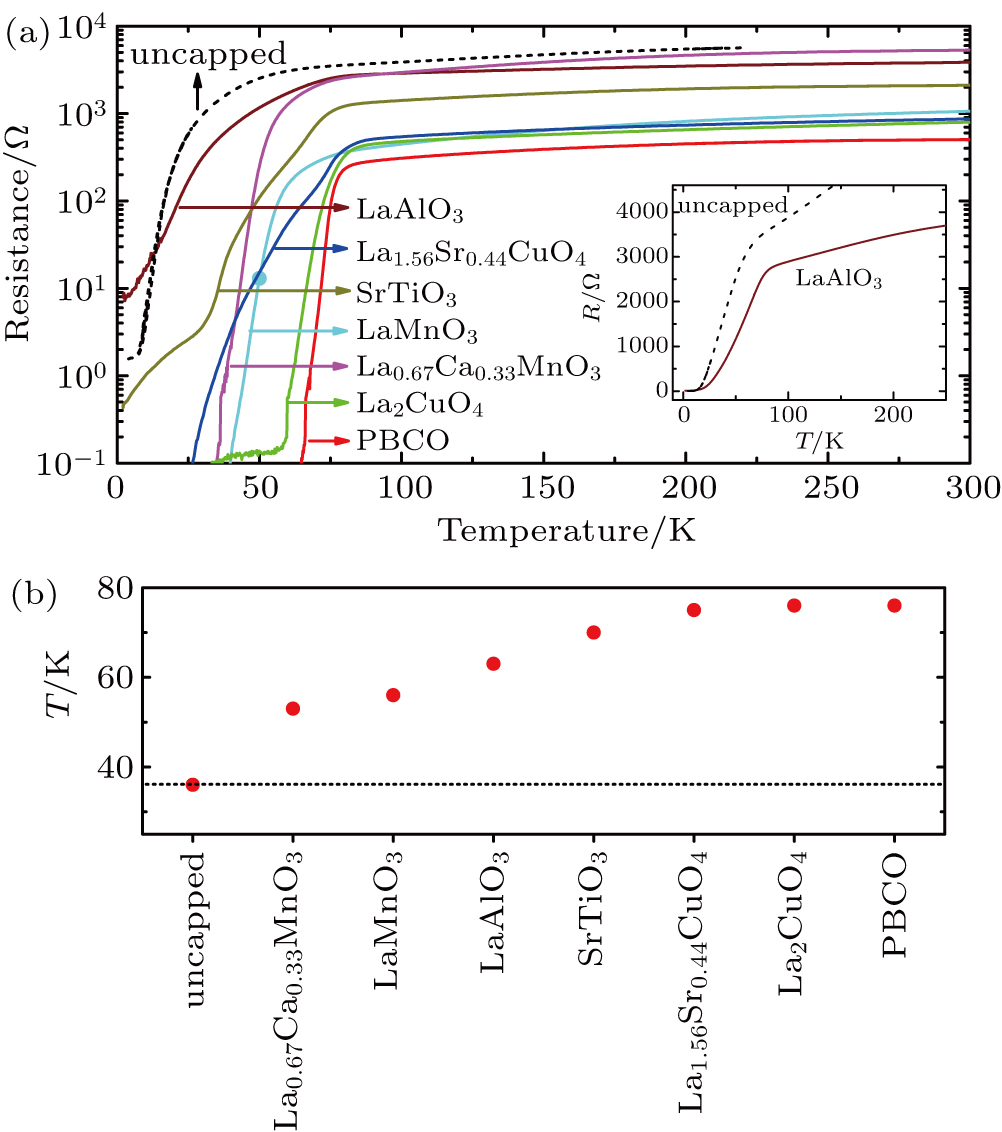† Corresponding author. E-mail:
In this study, we have explored the ways to fabricate and optimize high-quality ultrathin YBa2Cu3O7-δ (YBCO) films grown on single-crystal (001) SrTiO3 substrates. Nearly atomic-flat YBCO films are obtained by pulsed laser deposition. Our result shows that the termination of SrTiO3 has only a negligible effect on the properties of YBCO. In contrast, we found that capping a non-superconducting oxide layer can generally enhance the superconductivity of YBCO. PrBa2Cu3O7, La2CuO4, LaMnO3, SrTiO3, and LaAlO3 have been examined as capping layers, and the minimum thickness of superconducting YBCO with capping is ∼2 unit cells–3 unit cells. This result might be useful in constructing good-performance YBCO-based field effect devices.
The high-temperature superconductor YBa2Cu3O7-δ (YBCO) is still attracting intense attention.[1,2] Particularly, ultrathin films of YBCO have attracted significant research interest since the discovery of YBCO.[3–7] In the early days, a fundamental question as to what is the minimum thickness needed for the occurrence of superconductivity was raised because the layered structures of YBCO suggest a high degree of anisotropy.[3] Interestingly, it has been demonstrated that while single YBCO thin films lose superconductivity quickly when their thickness decreases to a few unit cells (uc), superconductivity has been achieved in as thin as 1-uc-thick YBCO layer embedded in superlattices that comprise YBCO and nonsuperconducting PrBa2Cu3O7 (PBCO)[5–7] or sandwiches of PBCO/YBCO/PBCO.[3,8,9] In addition to the above fundamental question, the major interest of ultrathin YBCO films lies in its promising application of electric-field-effect devices such as three-terminal high-temperature superconductor transistors.[10] Compared with conventional Bardeen–Cooper–Schrieffer (BCS) superconductors, YBCO has a much smaller carrier density, 3×1021/cm3–5×1021/cm3, which makes it intriguing to control superconductivity by electric field.[11] For this purpose, ultrathin YBCO films are needed because the tuning ability of the field effect is generally small. In addition, ultrathin YBCO films can also be used to construct an ultra-sensitive YBCO-based single-photon detector.[12]
As far as field effect application is concerned, unfortunately, superlattices[5–7] and sandwiches[3,8,9] are not very useful because an electric field can hardly penetrate these structures. For the optimization and future applications of YBCO-based field-effect devices, a high-quality ultrathin YBCO film that is directly accessible to gating materials is crucial.[10] Over the past two decades, electric-field effects on YBCO have been realized by either back gating through SrTiO3[13–15] or top gating through SrTiO3,[16,17] ferroelectrics,[18–20] or ionic liquids.[21–23] The ultrathin YBCO films used in these studies are either single[13,14,23] or buffered with PBCO.[17–20,22] Compared with the single YBCO, the PBCO-buffered YBCO has much better superconducting properties, and thus has been widely used in top-gating devices.[17–20,22] However, this strategy cannot be applied to the SrTiO3-based back gating devices because PBCO, rather than YBCO, is directly contacting with SrTiO3, the gating material. Instead, one would expect that a high-quality ultrathin YBCO film that is made directly on SrTiO3 and covered with a suitable capping layer should work well for the back gating. Despite the intense previous studies of YBCO,[24] little attention has been paid to optimizing ultrathin YBCO films in this way.
In this work, we explore the possibility of optimizing ultrathin YBCO films directly grown on SrTiO3 by controlling the termination of SrTiO3,[25] and by capping nonsuperconducting oxides whose structures are compatible with YBCO. Our result shows that the superconductivity of YBCO is insensitive to the terminations of SrTiO3, but can be generally enhanced by capping different oxides, including dielectrics such as SrTiO3 and LaAlO3.
All the films were grown on TiO2-terminated (001)-oriented SrTiO3 substrates by pulsed laser deposition using sintered polycrystalline targets. A KrF excimer laser (248 nm) was used with a laser fluence of 1.0 J/cm2 and a repetition rate of 1 Hz. SrO-terminated SrTiO3 was obtained by inserting 1-uc SrO on the TiO2-terminated SrTiO3 before growing YBCO (as shown in Fig.
First, we examine the effect of SrTiO3 termination on the properties of ultrathin YBCO films. Previous studies showed that the termination of SrTiO3 has a dramatic influence on the transport properties of LaAlO3/SrTiO3 heterostructures[26] and manganite films,[27] because it changes the sequence of atomic layers in LaAlO3 or manganite, which in turn changes charge transfer within the heterostructures or films. By analogy, in YBCO, charge transfer between different atomic layers plays a key role in superconductivity. Therefore, changing the termination of SrTiO3 may also have an important influence on the properties of YBCO.[28]
Figure
In Fig.
Next, we examine the effect of surface capping on the properties of ultrathin YBCO films. Unlike the buffer layer, the choice of the capping layer is almost unlimited because it is on the top and thus does not obviously influence the crystalline structure of the underneath YBCO. In the present study, in order to obtain a high-quality capping layer, we limit our choice to a few oxides whose crystalline structures are compatible with YBCO. In addition, we have reduced the postannealing time from 60 minutes to 30 minutes to optimize the surface quality of the capped samples. Most of these capped samples still have a quite flat surface with a root mean square roughness below 1 nm (not shown). Figure
The dashed line in Fig. 
Why can the superconducting properties of ultrathin YBCO films be enhanced by these capped oxides? One general possibility is that the capped oxides can work as a protection layer. It is well known that the surface of YBCO is chemically instable when it is exposed to air, mainly due to the reaction with water humidity and carbon dioxide. These deteriorations can be avoided by capping a protection layer. However, if this mechanism dominates, one would expect that all the capped oxides will enhance the superconductivity to a similar extent, which is clearly inconsistent with the result shown in Fig.
We consider two charge-transfer processes. For the single YBCO film, the defects on its surface can easily react with water humidity and carbon dioxide in air, which can generate high-energy-level electrons that will be transferred into the YBCO.[31] This process will reduce the hole concentration of YBCO and thus deteriorate the superconductivity. This process can be largely suppressed by surface capping. This is the reason why almost all the capped oxides can enhance superconductivity. The second charge-transfer process takes place between the capped layer and the YBCO. This process determines the apparent difference of capping different oxides. Hole injection by capping PBCO has been discussed in previous studies.[3] Besides PBCO, La2CuO4, La1.56Sr0.44CuO4, LaMnO3, and La0.67Ca0.33MnO3 are either a parent insulator of hole-type conductor or a hole-type conductor. They can provide holes to, or at least will not annihilate too much holes in, the YBCO. Therefore, the net effect of capping these materials is a significant enhancement of superconductivity in both Tc and transition region. The slightly lower Tc of LaMnO3- and La0.67Ca0.33MnO3-capped samples may be partially attributed to the interaction between superconductivity and magnetism.[32] SrTiO3 and LaAlO3 have different physical properties from others and cannot supply holes to YBCO. Particularly, the surface of LaAlO3 tends to react with water humidity. The high-energy-level electrons generated at this surface can still transfer across LaAlO3 into YBCO.[31] Therefore, it is reasonable that the net enhancement of superconductivity by capping SrTiO3 and LaAlO3 is relatively weak. The broad transition region observed in La1.56Sr0.44CuO4-, SrTiO3-, and LaAlO3-capped YBCO samples is a signature of inhomogeneity of superconducting region. It might be related to the capping-induced local inhomogeneity in structure, charge transfer, and oxidization.
Finally, let us determine what is the thinnest YBCO film that is directly grown on SrTiO3 and still shows superconductivity. Here, PBCO is used as the capping material because it enhances the superconductivity most effectively (Fig.
In summary, we have studied the effect of both the SrTiO3 termination and the nonsuperconducting capping layer on the properties of ultrathin YBCO films grown directly on SrTiO3. Our result demonstrates that the superconducting properties of the ultrathin YBCO films are insensitive to the termination of SrTiO3, but can be significantly enhanced by surface capping. This enhancement effect is very general and even applicable to dielectric materials. The minimum thickness of the superconducting YBCO ultrathin film obtained by capping is ∼2 uc–3 uc. This result may be of interest for designing more effective YBCO-based field effect devices.
| [1] | |
| [2] | |
| [3] | |
| [4] | |
| [5] | |
| [6] | |
| [7] | |
| [8] | |
| [9] | |
| [10] | |
| [11] | |
| [12] | |
| [13] | |
| [14] | |
| [15] | |
| [16] | |
| [17] | |
| [18] | |
| [19] | |
| [20] | |
| [21] | |
| [22] | |
| [23] | |
| [24] | |
| [25] | |
| [26] | |
| [27] | |
| [28] | |
| [29] | |
| [30] | |
| [31] | |
| [32] |







